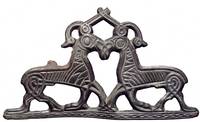Pre-Christian Cult Sites
-is a research project on the pagan religion of the Iron Age and Viking period.
Up until a few decades ago the fascinating world of Norse mythology was only known about from the written sources of the Early Medieval period, and the religion’s actual relationship with the people was not understood.
Archaeological remains from several magnates’ residences include evidence of the late pre-Christian religion, in a period when Norse mythology’s pantheon takes shape and changes occur in the way the religion is practiced.
The project will bring us toward an understanding of the religion, including its rituals and characteristics.


